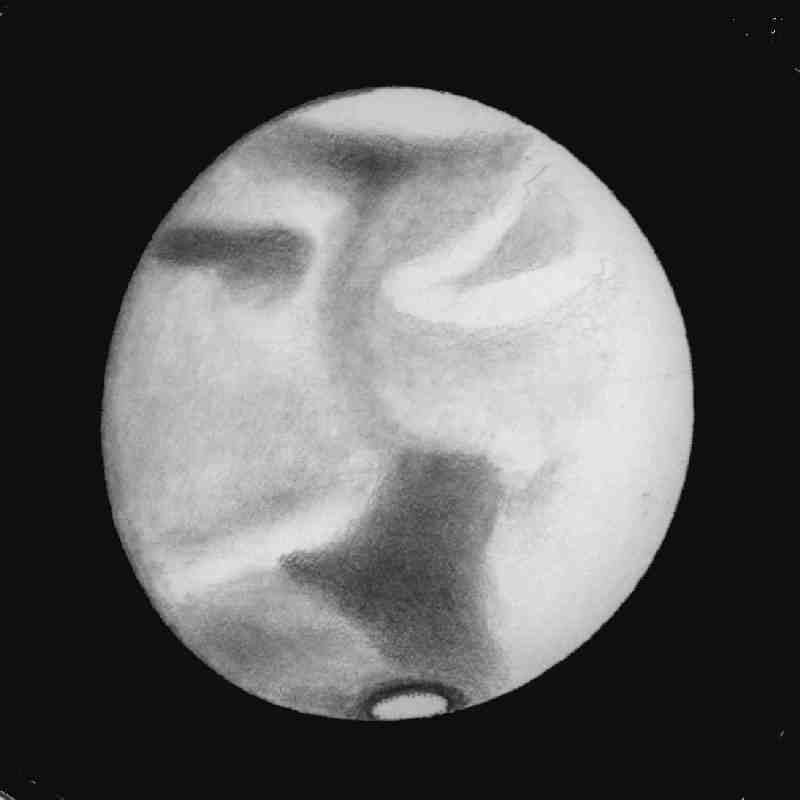
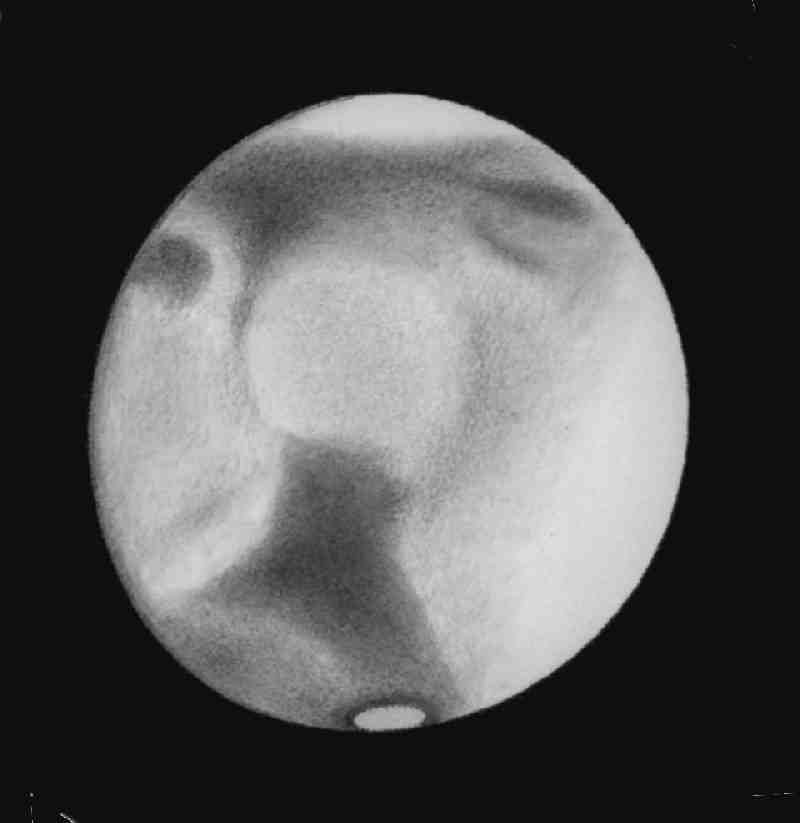
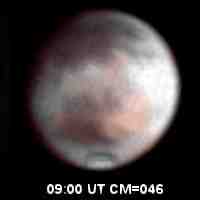
The apparent diameter (δ) was 9.1" on 16 February, while it went up to 11.9" on 15 March. The season moved from 098°Ls to 110°Ls. The phase angle ( ι ) went down from 34° to 27° during the period, and the central latitude (φ) from 17°N to 15°N (a minimum). The planet is stationary on 18 Mar, and will then slightly come up.
We acknowledge receipt of the Mars observations this period submitted to the CMO as follows:
* Fukui City Observatory AKUTSU, Tomio (Ak) Karasuyama, Tochigi, Japan
12 CCD Images (15, 16, 22, 25 February; 12, 13 March 1999)
f/60@ 32cm speculum equipped with a Teleris 2
BIVER, Nicolas (NBv) Hawaii, USA
4 Colour Drawings (7, 12 March 1999) 510× 26cm speculum
FALSARELLA, Nelson (NFl) Sao Jose do Rio Preto, Brasil
9 Drawings (13, 19, 24 February; 4, 5, 6, 10, 14, 15 Mar)
260, 325× 20cm speculum
GRAY, David (DGr) Kirk Merrington, Durham, UK
5 Drawings (21, 23, 27 February; 14 March 1999)
260, 350, 415× 42cm Dall-Kirkham
HIGA, Yasunobu (Hg) Naha, Okinawa, Japan
41 Video Images (14-17, 26 February; 2, 3 March 1999)
25cm speculum equipped with Sony DCR-TRV900
HIKI, Toshiaki (Hk) Minowa, Nagano, Japan
14 drawings (16, 19, 22, 25, 28 February; 1, 3, 4, 12 March 1999)
340, 360× 16cm speculum
ISHADOH, Hiroshi (Id) Naha, Okinawa, Japan
6 Drawings (20 February; 1, 2 March 1999) 400, 530× 31cm speculum
IWASAKI, Tohru (Iw) Kitakyushu, Fukuoka, Japan
13 Drawings (16, 18, 21, 27 February; 3, 5 March 1999) 400× 21cm speculum
MELILLO, Frank J (FMl) NY, USA
2 CCD Images (22 February; 14 March 1999) 20cm SC Starlight Xpress MX-5
MINAMI, Masatsugu (Mn) Fukui, Japan
53 Drawings (16, 25, 28 February; 1, 2, 12, 13 March 1999) 400× 20cm refractor*
MURAKAMI, Masami (Mk) Yokohama to Fujisawa, Kanagawa, Japan
18 Drawings (16, 21, 22, 23, 28 February; 3, 11 March 1999)
320× 20cm Saheki speculum
NAKAJIMA, Takashi (Nj) Fukui, Japan
30 Drawings (25, 28 February; 1, 3, 9, 11, 12, 13 March 1999) 400× 20cm refractor*
NARITA, Hiroshi (Nr) Kawasaki, Kanagawa, Japan
3 Drawings (19, 22 February; 13 March 1999) 400× 20cm refractor
PARKER, Donald C (DPk) Miami, FL, USA
23 CCD Images (17, 22, 24, 26, 27, 28 February; 3, 7, 10, 12, 13 March 1999)
f/55@ 41cm speculum equipped with a Lynxx PC
PEACH, Damian (DPc) King's Lynn, Norfork, UK
2 CCD Images (29 November 1998; 14 March 1999)
f/30@ 31cm Meade SCT equipped with an ST-7
TEICHERT, Gerard (GTc) Hattstatt, France
2 Drawings (13, 15 March 1999) 310,330× 28cm Schmidt-Cassegrain
WHITBY, Samuel R (SWh) VA, USA
5 Drawings (9, 15, 23 February; 5 March 1999) 310× 15cm speculum
David GRAY's dust cloud: On the morning of 21 Feb GMT at 100°Ls, David GRAY (DGr) had good images in spite of the planet being relatively low in the east, and detected at once a bright strange area through Wr25 in the morning side. The part showed a bright core in a cudgel-like shape at the southern part of Chryse: At 2:10 GMT with ω=012°W, M Acidalium was readily discernable as well as the north polar cap (npc), while in contrast the morning side of M Erythraeum was faded as well as much of Margaritifer S. S Meridiani and Niliacus L were also affected. By 3:00 GMT at ω=024°W, the core showed another branch, and the dust looked invading the morning side of the southern hemisphere. At ω=024°W, we usually see Aurorae S, but here it was missing. The following side of the disk must have been also thickly covered by a large morning white mist, but at that time the phase angle was 34° and so ω=024°W implied that the Noon line was around at 24+34=58°W, so that the core should be said to have already moved to the afternoon side. The position of the core looks as near as or slightly more north than the one found 27 June 1997 at 138°Ls by the HST, but the present one reached much east fading Margaritifer S. The drawing of DGr made two days later on 23 Feb (101°Ls) at ω=040°W proved that the dust had been almost dispelled, and Margaritifer S recovered, though Aurorae S was still faded. Solis L was seen and it became much darker at ω=050°W. Agathodaemon (Valles Marineris) was evident as a dark line. The morning limb side is light.



PARKER's dusty white cloud patch: Further three days later on 26 Feb (103°Ls) at ω=075°W, Don PARKER (DPk) showed by the CCD that Aurorae S was normal in Red. Chryse was white near the evening terminator. 27 Feb (103°Ls) at ω=052°W & 067°W, Aurorae S was also visible, and the afternoon Chryse was irregularly misted. PARKER (DPk) obtained a series of superb CCD images on 28 Feb (103°Ls) at ω=033°W, 043°W, 053°W (infrared) and 061°W: Chryse was now near at the CM, and the mist along the Northern Equatorial Band was shot irregular. In particular we can find a dusty white cloud patch inside the southern Chryse off Aromatum Pr. It is more evident on the image at ω=046°W, though also seen in other images. It is bright in Red and so it must be dusty, and also clearly visible in Blue so that it must also be water vapourised. It is unknown whether it is related with GRAY's dust or not. It is also unknown whether it or GRAY's dust caused a weeping the area off Orestes to be relatively darker (so looks here). The marking itself is already seen for example on the HST image on 27 June 1997. It is possible that PARKER's dusty white cloud is apparent on his image on 3 Mar (105°Ls) at ω=013°W, but the area is lost in the thick morning mist.
Cloudy Olympus Mons, Afternoon: A roundish white cloud atop Olympus Mons (we simply say Olympus Mons hereafter) is checked in Red images of DPk on 17 Feb (099°Ls) at ω=170°W while it is blurred on the Blue images. But his images on 22 Feb (101°Ls) at ω=122°W already shows a weak Olympus Mons isolated from the preceding more thicker Tharsis white region. This scene was also seen by FALSARELLA (NFl) on 19 Feb (099°Ls) at ω=105°W, and by WHITBY (SWb) on 23 Feb (101°Ls) at ω=119°W, though only the bright Tharsis without Olympus Mons.
On 25 Feb (102°Ls), Olympus Mons was caught at Fukui near the terminator at ω=175°W. It was just like a cotton-ball. On 26 Feb (102°Ls) HIGA (Hg)'s Video Tape recorded it edge on at the terminator at ω=202°W. On 28 Feb (103°Ls) at ω=186°W, MINAMI (Mn) saw it roundish near the terminator, and NAKAJIMA (Nj) estimated at ω=191°W its intensity to be 1.0, while the npc 1.5, and the southern limb 2.0. NAKAJIMA judged that it reached the terminator at ω=200°W. Since the phase angle was 32° and (200+32-135)/15=6.5, the local time was 6:50 pm, while the terminator 6.8 o'clock pm. An afterimage was visible at ω=205°W (by Mn). On 1 Mar (104°Ls), ISHADOH (Id) separated Olympus Mons at ω=177°W (cited here). On 2 Mar (104°Ls), Mn succeeded to catch the isolated roundish Olympus Mons at ω=140°W: It was separated by a dark band from the preceding Tharsis. At ω=160°W, Tharsis was whiter than the following Mons, while at around ω=180°W the latter became brighter, and looked like a cotton-ball. It was noted then that an evening mist was appearing to the south of Olympus Mons. On 3 Mar (105°Ls), IWASAKI (Iw) detected Olympus Mons and the dark band at ω=153°W, and it was distinct at ω=173°W. On 5 Mar (106°Ls) he faintly saw it at ω=135°W (at 2 o'clock pm local time). In 1997 we saw the cotton-ball at 075°Ls and phase angle: 25° when the app diam δ=11.5".
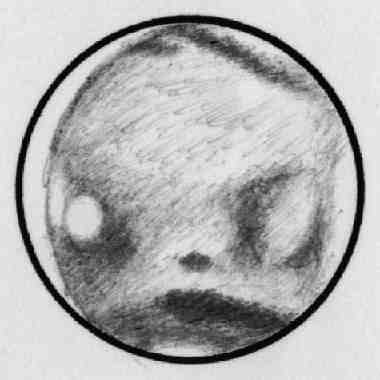
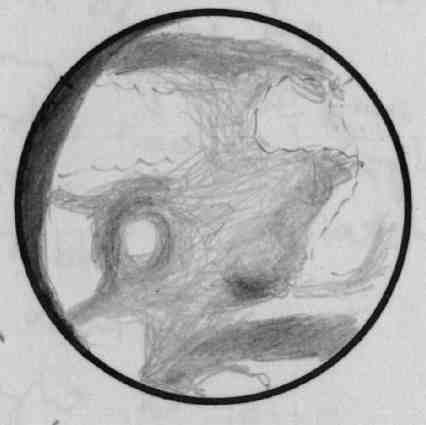
Excellent Video series of the afternoon Olympus Mons was obtained by Hg on 2 Mar (104°Ls) and 3 Mar (105°Ls). The 2 Mar images are from ω=158°W where Olympus Mons is clearly seen. At ω=179°W, it is evident as a bright spot. At ω=197°W, it is near the terminator. On 3 Mar, the first image at ω=139°W (at 17:10 GMT) is already good, and in addition to the description of Olympus Mons, it shows a complex inside the Tharsis cloud as well as the dark band between the two. Alba is also evident. The image at ω=158°W is also excellent. HIGA made this time an animation of the disks only with Blue images which is fascinating.
On 14 Mar (at 110°Ls) DGr saw Olympus Mons at ω=164°W, not so bright, but Alba looked considerably bright near the evening terminator. Propontis I was very evident as was the case by Id.
Tharsis, Morning: A large white (low) thick mist near Ascraeus Mons is seen on the CCD images taken by DPk on 24 Feb (102°Ls) at ω=083°W. A drawing on 7 Mar (107°Ls) by BIVER (NBv) at ω=081°W also shows the area light but not whitish however.
Evening mist and Elysium: Elysium at noon looks light but reddish, while it becomes whitish as it approaches the evening side. On 25 Feb (102°Ls) we watched the trend of Elysium at Fukui. Elysium made a shape at ω=194°W. NAKAJIMA recorded it to be off-white at ω=199°W. At ω=204°W, Elysium became distinct due to the coming up of the Aetheria dark patch (WHITBY (SWb) also depicted clearly Elysium at ω=204°W on 15 Feb by the use of Wr80A). At ω=214°W it became lighter, but not yet so whitish. At the moment it was noticed that an evening mist creped at the evening side to the south of Olympus Mons and went to Zephyria. Same situation lasted until ω=233°W, and the evening mist was seen invading Elysium at ω=243°W. Elysium was quite white at ω=253°W & 262°W. It was thus first observed that Elysium was not white misted alone, but enhanced by the evening southward mist from outside. The Video tape by Hg on 26 Feb (102°Ls) shows that Elysium is already whitish at ω=222°W. At ω=232°W it became quite white. Otherwise, Id caught the white Elysium in the evening on 21 Feb (100°Ls) at ω=256°W & 266°W. On 23 Feb (102°Ls) HIKI (Hk) saw the evening mist outside Elysium at ω=240°W.
On 13 Mar (109°Ls) at ω=271°W, DPk's CCD shows the bright evening Elysium. NFl did not however see the evening Elysium on 5 Mar (106°Ls) at ω=257°W.
Morning Elysium: The ω of 190°W is a key line: The CCD images of AKUTSU (Ak) on 25 Feb (102°Ls) at ω=194°W show Elysium in Red but not clearly in Blue. The observations by Mn on 2 Mar (104°Ls) showed that Elysium was covered by a morning mist at ω=160°W & 170°W and lasted until ω=189°W. On the other hand, Hg on the same day took a butterfly-like doubled mist at ω=187°W, the preceding one being at Elysium and the other outside the Aetheria dark patch. Even at ω=197°W, the Tape shows a whitish Elysium which however decreases. 3 Mar (105°Ls), Hg's Tape shows a mist still at ω=178°W, and at ω=187°W the butterfly becomes evident. If seen in Blue the bright part in Elysium is more compact than expected, and so we are suggested it is Elysium Mons, but we reserve here the conclusion on this matter because we experienced similar case concerning Ascraeus Mons in 1997. The Video Tape further shows this white spot until ω=197°W and ω=202°W. This butterfly-like doubled clouds must be similar to the one observed by Hg in 1997 on 20 Apr (107°Ls) (cf #204 p2285). This must be caused by the presence of the Aetheria dark patch which is now darker at the southern part. Note however that the Noon line in 1997 lies in the other evening side, so the situation is quite different.
Cebrenia: The streak of Cebrenia has an off-white tint on Hg's Tape on 2 Mar and 3 Mar. Ak's CCD on 22 Feb (101°Ls) at ω=260°W also shows a light Cebrenia in Red. PEACH (DPc) in UK obtained CCD images on 14 Mar (110°Ls) at ω=200°W and 208°W in which Elysium makes a light Y-shaped area with Cebrenia. (DPc sent already us further work on 17 Mar and 19 Mar as to which we refer in the coming issue: The images on 19 Mar contain Blue images.) PARKER (DPk)'s CCD on 13 Mar (109°Ls) at ω=271°W, Cebrenia looks reddish while Elysium being white near the terminator.
Noachis: MURAKAMI (Mk) felt Noachis at the s limb to be light separated from the preceding Hellas on 16 Feb (098°Ls) at ω=312°W, and verified the fact at ω=322°W and ω=332°W (Mk observed six times the night every 40 minutes). MINAMI (Mn) also noticed at ω=315°W on the same day a hazy lighter limb following Hellas, and at ω=322°W, Hellas decreased while the s limb Noachis was largely light. The Video Tape of Hg also separates Hellas and Noachis at ω=312°W, and the latter becomes distinct at ω=323°W. The CCD images of DPk on 7 Mar (107°Ls) however don't show so clearly the lighter part except for the morning side.
Chryse morning mist: HIGA's Video Tapes on 14 Feb (097°Ls) and on 16 Feb (098°Ls) proves that Chryse is thickly white misted near the morning side at ω=329°W and ω=334°W respectively. This is also checked by naked eyes: On 16 Feb Mk pointed this fact at ω=332°W (the local time of Thymiamata was 11:45 am), and Mn also thought the thickness was at peak at aroundω=334°W. On 24 Feb (102°Ls), FNl saw it at around ω=000°W. On the other hand, the CCD Red images by DPk on 7 Mar (107°Ls) at ω=331°W reveals Oxusseen through the white mist. On 12 Mar (109°Ls), NBv drew the white morning mist at ω=340°W.
Evening mist from Libya to Chryse: As was reported in the preceding extra issue, the present writer (Mn) chased Hellas on 16 Feb (098°Ls, ι =34°), but at the same time observed the Libya evening mist. At ω=290°W, we saw a mist from the area of Elysium, but at ω=300°W, we noticed it staying at Libya. At ω=310°W it invaded and covered Syrtis Mj, and at ω=320°W the mist made Syrtis Mj faded and went to Aeria. At ω=334°W, the same was seen lasting. At ω=339°W, the mist was connected with the morning Chryse thickly hazed and made a weak long-extending mist along the Northern Equatorial Band. At ω=349°W, Syrtis Mj was no longer visible, but the Libya mist remained as an evening mist. Note this depended on the value phase angle=34°. MURAKAMI (Mk) also chased from ω=303°W to ω=332°W on the day, and saw a faint Syrtis Mj pinched by the Libya mist and the Aeria one. On 20 Feb (100°Ls) Id observed the Libya whitish misty light at ω=302°W and ω=314°W. On 7 Mar (107°Ls, ι =30°) DPk shot the Libya mist invading clearly the northern Syrtis Mj at ω=321°W, 331°W and 342°W. Succeedingly on 10 Mar (108°Ls, ι =29°) DPk's CCD showed at ω=293°W and ω=304°W that the Libya mist ran along the Northern Equatorial Band to the morning Chryse crossed over Syrtis Mj that was quite inside the disk.
Syrtis Major: The present writer (Mn) observed on 16 Feb (098°Ls, ι =34°) at ω=322°W that the northern part of the evening Syrtis Mj was blue-greenish covered by the white Libya mist, while the southern part was dark up to the terminator. On the other hand, in the morning side, MURAKAMI (Mk) observed on 21 Feb (100°Ls) at ω=236°W that the morning mist was thick at the Aeria side. At ω=253°W, Syrtis Mj became darker than Utopia. On 25 Feb (102°Ls), Mn caught Syrtis Mj thin at ω=223°W well inside the morning mist. At ω=233°W, it was still faint, but at ω=243°W it showed a blue-greenish tint. HIGA's Tape on 26 Feb (102°Ls) shows Syrtis Mj faintly at ω=222°W. At ω=232°W it is definite.
Hellas: We collected the Japanese observations of the brilliant Hellas in mid-February in the report of the preceding issue. Hellas was again caught in America. PARKER (DPk) produced several good images, and the Red one on 12 Mar (109°Ls) taken at ω=292°W shows a shade inside at the southern limb. The width of Hellas in DPk's images looks quite different from Red to Blue.
Argyre: The Martian tilt now makes us see Argyre more easily at the southern limb. In Japan it was seen on 12 Mar (109°Ls) and so on. A haze from Argyre to its morning side was detected by BIVER (NBv) on 7 Mar (107°Ls) at ω=059°W. The morning haze was also seen on DPk's CCD on 28 Feb (103°Ls).
Mist along the Northern Equatorial Band: None was strong, but a weak mist elongation was observed several times: For example, HIGA (Hg)'s Tape shows it on 15 Feb (098°Ls) at ω=333°W. On 27 Feb (103°Ls) at ω=311°W, GRAY (DGr) observed by the use of Wr47B a broad mist belt from Libya to Chryse. Syrtis Mj was normal in Int and Wr15. Every DPk's CCD on 7 Mar (107°Ls) shows it weakly from ω=321°W to ω=342°W. On 12 Mar (110°Ls), AKUTSU (Ak) showed it at ω=097°W, while PARKER (DPk) at ω=292°W. All are not listed here. The series of condensations seen along the NBE on DPk's image on 28 Feb may also belong to this category.
North circumpolar region: Because of the tilt, the npc looks flat now but well bright. Olympia and Hyperboreus L are also visible. WHITBY (SWb) watched the latter on 5 Mar (106°Ls) at ω=014°W and 028°W. DPk's CCDs also depict it clearly. According to DGr, the npc on 27 Feb (103°Ls) looked larger than expected in Wr15. He observed strata of veils at the circumpolar region at ω=317°W ~ 321°W, but without a description of Olympia. NBv also observed a haze outside the npc on 12 Mar (109°Ls) at ω=340°W.
Miscellaneous: The markings from Mareotis L to Ascraeus L, densely reddish in themselves, were caught by NBv rather faintly on 7 Mar (107°Ls) at ω=059°W & ω=081°W. On 12 Mar (109°Ls), HIKI (Hk) depicted them densely at ω=075°W, 087°W, and 097°W. Mn also chased the area on the same day from ω=060°W to 095°W, and on 13 Mar (109°Ls) from ω=060°W to ω=089°W, and saw the markings appear quite dark. AKUTSU (Ak) took it on 13 Mar at ω=059°W. The day Ak observed by CCD at ω=020°W, 040°W, 049°W, 059°W, and 070°W: the last image being most excellent. On 14 ‚lar (109°Ls), MELILLO (FMl) shot Syrtis Mj and Hellas in Red (Wr25): Hellas large evident while Syrtis Mj unstable in his images.
We further received: PEACH (DPc)'s image on 29 Nov 1998 (063°Ls) was made at ω=159°W and shows a large npc and the dark area surrounding it. Alba looks bright near the evening terminator. The apparent diameter was 5.2". The drawing by SWb on 9 Feb 1999 (095°Ls) shows the surface at ω=247°W where Elysium light in the evening and Hellas bright in the morning; Syrtis Mj was dark well inside the disk.